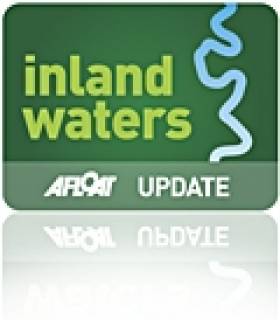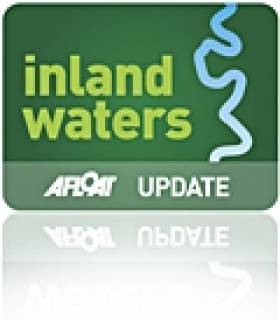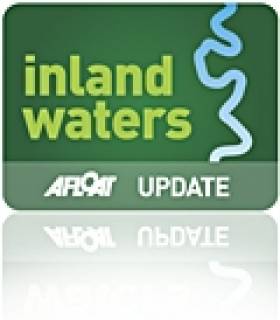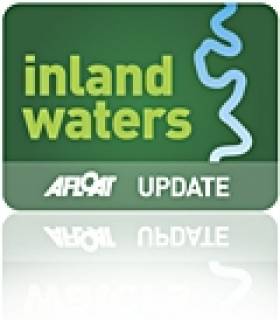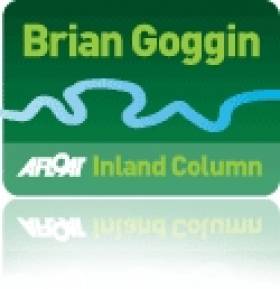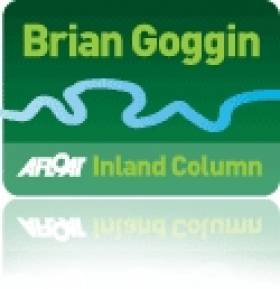Displaying items by tag: Waterways Ireland
Lock One Repairs Complete On Shannon-Erne Waterway
#InlandWaterways - Waterways Ireland advises masters and owners of vessels that repairs to the lock and gates at Lock 1 Corraquill on the Shannon-Erne Waterway in Co Fermanagh which began on 29 January have now been completed.
Grand Canal City Dredging Works Completed
#GrandCanal - Waterways Ireland has issued notice that dredging works on the Dublin Main Line of the Grand Canal between Portobello and Inchicore have now been completed.
As previously reported on Afloat.ie, the works between Lock C7 at Portobello and Lock 2 at Davitt Road were instigated to keep the canal navigable for a large range of boats.
The dredging works involved the removal of sediment deposits from the central navigation channel and the clearance of rubbish.
Meanwhile, major renovation works on the city terminus of the Grand Canal at Ringsend Basin are ongoing with a view to completion in mid May.
Flow Measurements, Weir Inspection on Shannon
#InlandWaterways - Waterways Ireland advises that the Office of Public Works (OPW) is presently conducting flow measurements in Athlone and Banagher on the Shannon Navigation till Thursday 21 March 2013.
The measuring instrument will be lowered from the bridge to the river and then moved laterally across the bridge arches to take the measurements. The procedure will only take a matter of minutes at each arch.
Masters approaching the navigation arch of these bridges should be prepared to stop short and await instructions from OPW staff as to when it is safe to proceed through the arch.
Meanwhile, masters of vessels on the Shannon-Erne Waterway are advised that underwater inspection of weirs shall commence next Tuesday 19 March to be completed on Wednesday 3 April.
Masters approaching weirs should be prepared to stop short and await instructions from the dive safety officer before proceeding.
Lowtown's Public Moorings to Open Shortly
#lowtown – Waterways Ireland's work to redevelop the moorings and other amenities on the Grand Canal and Old Barrow Line at Lowtown, Co Kildare is nearing completion and will be opened shortly.
Waterways Ireland had already provided a new amenity block including toilets and showers at the area and has gone on to add extensive facilities for both touring boats and boats wishing to take an Extended Mooring. 350 meters of fixed timber mooring have been installed all of which have water & lighting and a proportion also have electricity.
On the Old Barrow Line and Grand Canal Main Line 100m and 80m respectively of fixed timber moorings, have been constructed with service bollards providing lighting and water.
Additionally on the Grand Canal Main Line 170m of fixed timber moorings have been constructed on the with service bollards providing electricity, lighting and water. The electricity provision is operated by smart card available from the Waterways Ireland webshop shopwaterwaysireland.org . Waterways Ireland has also constructed a dedicated parking area and bin area for boats using the long term facility.
A proportion of the moorings on the Grand Canal Main Line are being set aside for Extended Mooring Permit holders. The remainder will be for visiting boats displaying a valid Combined Mooring and Passage Permit (CMP) and following the 5 day mooring rule laid down in the Bye-laws. The balance between touring and extended moorings will be determined by the level of approved applications for Extended Mooring Permits.
The works, designed by Waterways Ireland and undertaken by LM Keating, Co Clare also included the construction of a canal overflow on the Grand Canal at Derrymullen in order to assist with the management of water levels.

New Waterways Ireland moorings on the Barrow line ready for the 2013 boating season
Application for Extended Moorings at Lowtown opened on the 4th March 2013, cost €152 for 12 months and are allocated on a first come, first served basis. Applicants need also hold a CMP (€126) and can apply using the same application form. The form can be downloaded from www.waterwaysireland.org or send out by post from Waterways Ireland Tullamore (Tel 057 9352300).
Boat owners with boats on the Grand Canal, Barrow Navigation and Royal Canal should be aware that from the 19th March the mooring bye-laws will be enforced.
More information is available from Shane Anderson, Assistant Inspector of Navigation: Tel no +353 (0)87 286 5726, Email [email protected] .
Enforcement of Mooring Bye-laws on Grand & Royal Canal & Barrow Navigation
#byelaws – Waterways Ireland will begin enforcement of the mooring Bye-Laws on the Barrow Navigation, Grand Canal and Royal Canal on the 19th March 2013. A Marine Notice will be issued on the 19th March to this effect.
The enforcement process will begin with non-permitted, sunken and abandoned boats already on the system. The first step in the process is notification. Continued non-compliance with the Bye-laws may result in the craft being removed from the navigation and stored at the owners cost.
A one year permit for passage and 5 day mooring costs €126. A year-long mooring permit for a single location costs €152. For boats already on the canal system, both permits must be applied for in advance of the 19th March 2013 and be on display on the boat by the 31st March 2013.
New boats visiting the Grand Canal, Royal Canal or Barrow Navigation for longer than 1 month may apply for the CMP in advance of arrival on the system and must apply for the Extended Mooring Permit as soon as they plan to remain for longer than five days in a single location.
The application process is simple using a form that can be downloaded from www.waterwaysireland.org or sent out by post from Waterways Ireland Tullamore (Tel no 057 9352300).
Waterways Ireland has extended the number of Authorised Officers, who under the Bye-laws have the authority to undertake enforcement.
More information is available from Shane Anderson, Assistant Inspector of Navigation: Tel no +353 (0)87 286 5726, Email [email protected] .
Notice of Upcoming Restrictions at Sarsfield Lock
#InlandWaterways - Waterways Ireland wishes to advise masters and owners of vessels and boats on the Shannon Navigation that Sarsfield’s Lock in Limerick will be operated on restricted service from Thursday 28 February to Saturday 9 March 2013.
During this time the lock will only operate from 10am to 12.30pm daily.
Masters and owners are requested to ring the lockkeeper at 087 797 2998 one day prior to making their passage.
Emergency Exercise on Shannon-Erne Waterway Next Weekend
#InlandWaterways - Waterways Ireland advises all masters of inland vessels and the public that the Emergency Services will conduct a major water-based exercise centred on Upper Lough Erne and the Shannon-Erne Waterway next Saturday 16 February 2013.
The areas of Geaglum, Derryadd, Kilmore, Corradillar and Naan Island in Upper Lough Erne will all be affected between the hours of 10am and 10pm, while Ballyconnell on the Shannon-Erne Waterway will be affected between 2pm and 6pm.
Waterways Ireland Offers Site Visits to Primary Students
#waterways – Waterways Ireland is hosting a series of site visits on the 27th February 2013 on Ireland's navigable waterways as part of Engineers Week 2013. Two site visits are on offer to primary pupils to visit the Royal Canal in Mullingar.
On the site visit to the Royal Canal, Waterways Ireland engineering staff will lead tours of Mullingar Harbour giving information about the canal and its history and present use. Students will also have an opportunity to view a dry dock. Led by the Senior Engineer, her team will also be in attendance to explain the background to the reopening of the canal and the impact the works have made.
Engineers Week is a week long programme of nationwide events with the aim of celebrating the world of engineering in Ireland. It is an ideal opportunity to highlight the range of work undertaken by the engineering staff of Waterways Ireland. Waterways Ireland employs civil and mechanical engineers and technicians on a range of projects on all seven navigations managed by the organisation. Projects include navigation operation, maintenance and development, structural design, project management, fleet management, development and maintenance of electro-hydraulically operated lock gates and accompanying smart card system and many more.
The trips start at 10am and 1pm on Wednesday 27th February and running for 1hrs, the trip is primarily suitable for national school pupils. Booking is essential and is on a first come, first served basis. To find out more information and book places on any of the site visits offered by Waterways Ireland, contact Katrina Mc Girr on +353 (0)71 96 50560. A maximum of 30 pupils can be accommodated.
A site visit to the Shannon-Erne Waterway is also planned for the 27th February.
Making Waves On The Canals
There's an old joke about a Scottish hellfire preacher trying to educate his flock about the punishment awaiting them if they do not mend their ways. He tells them that the ungodly will find themselves in the flames of hell, suffering unimaginable torments, and that they will cry to the lord for mercy, saying "Laird, laird, spare us: we didna ken whit torments awaited us." And, he tells them, the lord in his infinite goodness and mercy will gaze down upon them from heaven and he will say unto them "Well, ye ken noo".
WI and the canals
Some folk with boats on the Royal, Grand and Barrow may be feeling a bit like the ungodly at the moment, with the role of the lord being played by Waterways Ireland (WI). It seems that, as predicted here, WI is finally moving to take control of its canals.
Several new initiatives are under way, more are promised, some are predicted — and all in all it probably amounts to the biggest set of changes to boating on the canals since the end of commercial carrying. Furthermore, there are suggestions that the canals are being seen as a pilot study: that some of the changes will be applied to the Shannon and the Erne in years to come.
Cheap boating
Until now, you could keep a boat on the canals for e126 a year. That covered as many miles as you wanted and passage through as many locks as you wanted; it also covered mooring for the year. There is a bye-law that says you must not stay in one place for more than five days at a time, but it was widely ignored and scarcely ever enforced.
So you could, for example, keep your boat near Dublin, perhaps at a location close to a railway station, and live on it all year round. Or you could keep it there in the winter and move to the Shannon end for the summer, basing your boat at Shannon Harbour (Grand Canal), just one or two locks away from the Shannon, or at Richmond Harbour (Royal Canal), just one lock away. The cost was well below that of a Shannon marina berth.
The bye-laws simply did not reflect the ways in which people actually used boats, either as pleasure craft or for living on. And the charges to users were well below the cost of competitors' products (e.g. commercial marinas' charges), well below the charges on UK waterways and, in particular, well below the cost of running the waterways.
Costs to taxpayers
In the year ended 31 December 2010, WI's operating income, excluding "net deferred funding for pensions", was e547,000. That's the total for all waterways, coming from licences (e34,000), property (e210,000), operations (e202,000), interest (e1,000) and other (e100,000). The programme costs (excluding staff and other costs) were:
• Barrow e723,000
• Grand e2,074,000
• Royal e2,873,000
• the rest e2,098,000.
So the Grand, by itself, cost almost as much as the Lower Bann, the Erne, the Shannon and the Shannon–Erne Waterway put together. The Barrow, Grand and Royal accounted for 73% of the costs but for a far lower proportion of the boats and the income.
I don't intend that as a reflection on the efficiency with which the different waterways are operated: canals are entirely different in nature to river and lake navigations, with far more waterways infrastructure, and will cost more to run. But I give the figures for two reasons. First, they show that, if WI wanted to reduce the gap between income and expenditure, it would inevitably focus on the canals. Second, the figures give some idea of the extent of the subsidy being provided by the taxpayer to canal-based boaters: if there are, say, a thousand boats based on the canals and Barrow, each of them is being subsidised by (on average) about e5,500 a year from the taxpayer.
Costs to boaters
I'm always inclined to look at the economic angle, but WI doesn't dwell on it. Nonetheless it will increase the costs to boaters and will also increase WI's income. Instead of a single e126 annual charge, boaters will now pay
• e126 for a Combined Mooring
& Passage Permit
• e152 for an Extended Mooring
Permit (EMP)
• e250 as a damage deposit,
which I presume will be rolled
forward in succeeding years.
Furthermore, boaters applying for Extended Mooring Permits (EMPs) must produce insurance certificates; for anyone currently uninsured, that will be an extra cost, as will any survey and remedial work required.
There will be other extra costs, of which more below, in future years.
Controlling mooring
At the core of WI's current activity is its taking control of the banks. It is marking out lengths that can be allocated to boats; it will allocate those lengths to those applying for EMPs. It does not guarantee that boaters will get their preferred spaces, or that they will get the same space every year. But once a space has been allocated, it is reserved for one boat for the year and cannot be used by another. That probably seems obvious to anyone renting a marina berth but it will be a new practice on the canals.
The EMP system was applied first at Rathangan and Vicarstown on the Barrow Line, between Lock 34 and Griffith Bridge on the Grand and at Confey (Leixlip), 15th Lock and 45th Lock (near Richmond Harbour) on the Royal. The second batch will include places in the Grand Canal Dock in Dublin, at Pike Bridge, near Maynooth, and at Abbeyshrule on the Royal and near Lock 34 on the Royal. There will be more batches through to spring 2013; full details on http://www.waterwaysireland.org; select New Canal Permit System from the menu on the left.
Continuous Cruisers (as they're called in Britain), folk who stay no more than five days in one location, will not be required to have EMPs.
So what happens if a boater doesn't apply for an EMP but doesn't cruise continuously? If I'm reading the bye-laws correctly, WI has the power to remove a boat, store it and, if necessary, sell it, charging the owner for the costs of doing so.
Information or consultation?
There has been some criticism of WI for not holding consultation meetings before beginning to implement its new policy. My own view is that WI was right: such meetings produce more heat than light, with too much attention on minor individual matters and not enough useful comment on the principles. There is much to be said for creating facts on the ground.
But if consultation has been restricted, the flow of information has not. In fact WI has used its website very effectively, setting out its plans, explaining the procedures and providing FAQs with useful, not PR-type, answers. Whoever has been in charge of that exercise deserves to be commended.
Insurance and dry docking
One thing WI has communicated is that there is more to come.
From 2015 Waterways Ireland will be introducing the requirement for boats needing permits and wishing to use the canals to have a current hull survey to provide evidence that the boat is in good condition. [...] Your attention is being drawn to this requirement now to allow you time to prepare for 2015. [...]
The Licensee undertakes to have regular inspections of the gas and electric services of his Boat as required to ensure these are kept in a safe and serviceable condition. [...]
All Boats must carry adequate fire fighting equipment and have same serviced as per the manufacturer's recommendations. [...]
It is not permitted to re-fuel Boats at an extended mooring.
The requirement for insurance will probably mean more boats needing hull surveys; there is an explicit requirement for such surveys from 2015 onwards. That will put extra pressure on the dry docks, where WI has already introduced restrictions on the boats that can use them and the work that can be carried out. There is, in my view, an urgent and growing need for well-capitalised, well-managed boatyards along all our waterways. The requirements also suggest a need for more fuel sellers along the canals; as far as I know the only one is at Lowtown.
The Shannon and the Erne
The new arrangements will mean better management of the canals, safer boats and more income from WI, all desiderata. But the real excitement would come with their extension to the Shannon and the Erne. The legal basis for charging might have to be different, but WI must surely be planning to raise much more money from Shannon and Erne boaters. The current Shannon lock and bridge fees are pathetically small, hardly worth collecting, and they are not paid at all by those who stay on the lakes.
I am writing this before the Republic's budget is published, but I cannot imagine that it will contain good news for WI. I suspect that it will have to raise much more money itself, and that means from charges to various types of users. Robin Evans, chief executive of Canal & River Trust, which runs the former British Waterways navigations in England and Wales, said recently that his organisation gets only 35% of its funding from the State. The Irish Government must look enviously at that figure.
But it must consider the price elasticity of demand for inland boating. Usage, as measured (however imperfectly) by Shannon lock and bridge passages, has been falling over the last ten years. The chart below shows the figures for the first ten months of each year: at time of writing, figures for November and December 2012 were not available.
It may be time to reinvent the Shannon once again.
Down On Derg
For the last couple of years, we've done some long-distance boating; indeed in 2011 we didn't get to Lough Derg until the end of September. So we decided that, this year, we were not going anywhere north of Portumna: we would spend the year down on Derg.
Here are some of my impressions of the season. Some of them I may be able to check later, by looking for statistics or reports; some can't be checked because there are no statistics.
Weather
My first impression is that summer ended some time around May, with relatively little sunshine after that.
Even the nature of bad weather seems to have changed: the Royal Canal ran out of water in Spring but the Shannon had rather a lot of water throughout the summer. From time to time reports came from upstream of strong flows that made navigation difficult; down on Derg, Killaloe seemed to have strong currents quite a lot of the time, with water being pulled down the headrace to Ardnacrusha.
Met Éireann's report for the summer (June, July, August) seems to support that view: rainfall above average, sunshine and temperatures below average. It also seemed to me that we had more northerly winds than usual: the south-westerlies didn't seem to be the prevailing winds. However, the report says nothing about winds.
Numbers
My second impression is that lots of people have disappeared: that very few boats were moving on the lake this year: it was as if we were back to the early 1980s. I'll get the traffic figures from Waterways Ireland later: they cover only passages through locks and moving bridges, so they don't say anything directly about lake traffic, but they do give an idea of volumes.
Now, I may not be the best judge of numbers of boat movements because, if I hear there's a big boaty event on, I go somewhere else. But there seemed to be times when there was nothing moving on the middle of the lake, except sailing boats racing from Dromineer, Garrykennedy or Mountshannon. There weren't even many jetskis or speedboats around.
There were rumours of larger boats being sold to overseas buyers and transported out of the country, but I don't know how to check that. Even checking the total number of Shannon boat registrations wouldn't help: as there is no annual registration fee, there is no incentive for former owners to de-register boats that have been sold.
Dromineer
My third impression is that shore-based activity has diminished too.
As we keep our boat in the Shannon Sailing marina in Dromineer, we don't often use the public harbour, but we drive by it en route to the marina. It seemed to me to be pretty lifeless. Numbers of visiting boats seemed to be down (while numbers of resident boats rose), as did numbers visiting by land. (I don't know of any source of statistics for this; if there is one I'd like to know.)
I imagine that the poor weather kept land visitors away, except on the few sunny days. But I don't think that the improvements made a few years ago — path, pebbles, seats and so on — have done much to attract people. Dromineer needs to do more to establish itself as a place to visit, with things for people to do when they get there.
Harbour hoggers
My fourth impression is that harbour-hogging — leaving boats in public harbours for more than the permitted numbers of days, instead of paying for berths in private marinas — is on the increase. I don't know of any statistics on this, although I suspect that Waterways Ireland may have some. Its staff do patrol the harbours and record registration numbers, occasionally applying stickers to errant boats, so I imagine that they keep records of the numbers.
The problem is that WI has very little power, under the current bye-laws, to do anything effective. It needs a simple, cheap method of imposing ever-increasing charges on harbour-hoggers — and of enforcing payment. Experience with both the household charge and the mineral oil tax suggests that drastic steps may be required.
Other privatisers
The same may apply to other services that WI provides. Its very welcome supply of electricity can at least be controlled, with charges paid by card. However, I suspect that, when water charges are introduced, WI will have to devise a method of charging for water. Whether or not it wants to subsidise boaters, it is unlikely to want to supply folk who drive to its harbours to fill barrels and bottles with water (I have photographed folk doing just that).
And then there's the rubbish problem. Bins have been removed from some harbours on the west side of Lough Derg; a WI notice says that it has a "Leave No Trace" policy, or some such thing. That doesn't explain why there are still bins at harbours on the east side; I suspect that the explanation is in different arrangements with different local authorities. However, overseas tourists (if there are any) are likely to find it a little inconvenient to bring their holiday rubbish home with them, especially if they're flying by Ryanair.
But you can see WI's problem: if it makes free bins available, folk will drive from miles around to avoid paying charges. So, given that Irish folk are unlikely to develop civic-mindedness in the near future, the best solution is to use smart-card controlled bins, with each opening of the lid traceable to the individual boat-owner (or camper-van-owner). The same cards could control the other services and provide WI with a way of tracing user movements.
Supply and demand
The problem with free services is that they're too good to last: the provider, especially if it gets its money from an overstretched state, eventually realises it can't continue to provide them for nothing. So, just as declining income and other pressures reduce demand for its product, Waterways Ireland may find itself imposing extra charges that further reduce demand. It is not clear that any marketing campaign can compensate for the economic pressures on the sector.


























